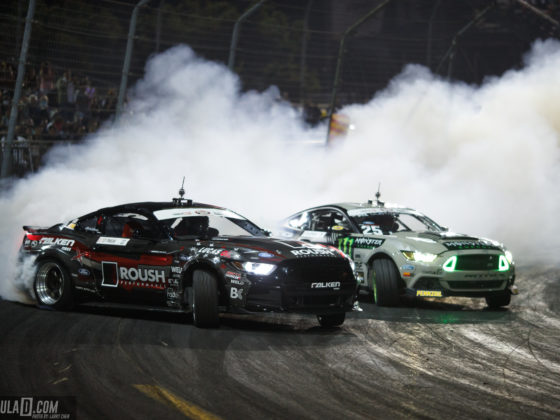So just how do you go about improving a turbocharger’s transient response while maintaining very high reliability and low cost? It’s evident that more than just a material change is required. We already know that lighter is better to improve transient response. In addition to mass, rotational inertia is affected by geometry; the closer the mass to the axis of rotation, the lower the inertia and the faster things will spin up.
A few other concepts related to improving a turbo’s transient response include compressor to turbine wheel matching, turbine efficiency, and Blade Speed Ratio (U/Co). U is the blade tip speed and Co (called C naught) is basically the speed of the gas flow into the turbine wheel. Co is also known as the spouting velocity and is defined as that velocity which has a kinetic energy equal to the isentropic enthalpy drop from turbine inlet stagnation pressure to the final exhaust pressure; so for our purposes, it is basically the velocity of the gas into the turbine wheel. For the commonly used radial flow turbine wheel in turbochargers, a ratio of approximately 0.7 is ideal for maximum efficiency. So we know mass, inertia, wheel matching, turbine efficiency, and Blade Speed Ratio all factor into transient response. Garrett went back to basics, reanalyzed the problem, and developed a completely new concept for a turbocharger. The concept pairs an axial flow turbine wheel to a dual-sided compressor wheel to create a turbocharger called DualBoost™ for Gasoline.
The really fundamental change is going from a radial turbine wheel to an axial turbine wheel. The axial turbine wheel address the need for improved transient response on two fronts: improved turbine efficiency at low U/Co and reduced rotational inertia. The thing we have to remember about piston engines is that the flows are pulsating and not constant. Pulsating flows leads to pulsating U/Co values and therefore varying levels of turbine efficiency.








13 comments
I Googled, Garret dualboost turbos. I found info back to 2011-12 on forums. But if you go to Garrett website there is no Dual boost turbos for sale and we are in 2018.
Why has this technology still not been offered to the general public at least for aftermarket applications?
What’s interesting is this tech is, somewhat, already on the road. The Ford 6.7 diesel uses a turbo that has this technology on the compressor side, but is otherwise conventional with the turbine. It should be no surprise that the 6.7 turbo is from Garrett.
Are these turbos available from Honeywell or garrett?
What about the VNT turbos?
Tarik, in full disclosure, please know that I work for Honeywell Transportation Systems (TS).
Honeywell is the company; Transportation Systems is the business unit making Honeywell turbos for OEM factory applications; and.. for now… Garrett is our aftermarket brand.
I write “for now” because Honeywell announced plans in Oct 2017 to spin TS into a publicly traded, stand-alone company by the end of Q3 this year. We have subsequently announced the intention to return to our roots and rename the new company Garrett once that happens. https://turbo.honeywell.com/whats-new-in-turbo/press-release/honeywell-announces-garrett-as-company-name-for-transportation-systems-business-after-spin-off/
Thanks Mike, so you’re bringing Garrett and TS together?
How’s this affect the availability of these turbos for the aftermarket?
Thank you!
No effect on our available product portfolio in terms of what currently exists. Again, Garrett is not currently a company, it is a brand. Everything behind the scenes that is TS which supports Honeywell and Honeywell Garrett Aftermarket stays in place.
In addition to the marketing change when we move to rebranding everything Garrett after the spin, the company will enjoy independent governance and the ability to be more responsive and agile to meet industry needs. This is the point of the spin, to give the new Garrett the means to respond more quickly and with greater capability to launch desired innovations in both its OEM and Aftermarket turbo businesses, as well as our electric boosting products and automotive software operations.
Mike, sounds great!
1: You said electric boosting products as in plural, does this mean you have electrically assisted turbos besides your electric compressor? Or are you referring to the Electro hydraulic controlled VNT turbos?
2: It’ll be great to see what Garrett is able to do with loosening the leash.
3: Are VNT gasoline turbos currently available for purchase? If so are they available in the 28/35/40 sizes??
I asked motoiq about this tech several years ago. Surprised it’s taken so long for people to talk about it. kinda hate how this tech is kept secret for so long.
When can I buy one?
Mitsubishi was using TiAl turbine wheels in Lancer Evolution RS models from the EVO6 (which came out in 1999) right up to EVOX.
I’m pretty sure the MHI turbo with TiAl turbine wheel was ONLY used on the Evo 6.5 Tommi Makinen Edition (TME) and it was prone to breaking off. In 2012, Porsche had to put a stop order on the Panamera Turbo because the MHI turbos had their TiAl turbine wheels breaking off again.
Tarik, it appears we’ve exhausted the “reply” function. Shoot me a note at michael.stoller@honeywell.com.
Yes! Finally something about dichter.